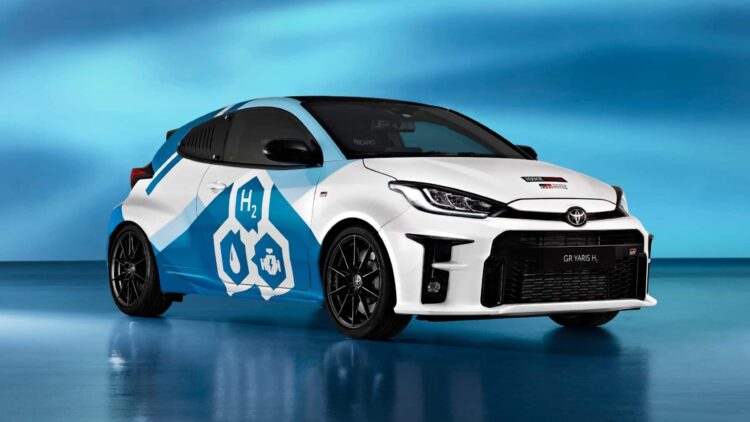Toyota has pulled out all the stops to remain competitive in the pursuit of carbon neutrality with the souped-up, hydrogen-powered GR Corolla they’ve got lined up to compete in the Super Taikyu Fuji Super TEC 24 Hours Race. Several new features make the engine one to watch on the track, including an extended cruising range created by a custom-shaped tank and enhanced durability of the liquid hydrogen pump. The model, tagged the #32 ORC ROOKIE GR Corolla H2 Concept, is fueled by liquid hydrogen, and Toyota will no doubt be hoping to gain insight from its track performance as there are still some bugs to be worked out the system.
Hydrogen-powered GR Corolla primed for Fuji Super TEC 24 Hours Race
The engine that Toyota has placed into the #32 ORC ROOKIE GR Corolla H2 Concept has several features that make it one to watch in the hydrogen class.
Enhanced durability of the hydrogen pump
The liquid hydrogen pump is the component that elevates the pressure of the liquid hydrogen fuel before it’s injected into the engine. This is something Toyota has put a lot of effort into improving in hopes of finishing the race without having to replace it. In the previous run of the Fuji Super TEC, Toyota went through three of these.
When moving hydrogen from the tank to the engine, the pump uses a reciprocating motion in the piston action. This generates higher pressure than a standard pump, and the shaft and gears’ rotation action is smoother. However, in the previous engine, the load was uneven, and the parts wore out quickly.
To get around this, Toyota included a dual-drive crankshaft mechanism. The adjusted application of torque translates into a more balanced boosting piston action, increasing durability significantly.
In the 2023 edition of the Fuji 24 Hours Race, Toyota used three pumps, each with an average durability of eight hours. In 2024, they hope to have no replacements and achieve durability for the full 24 hours and beyond.
Custom-shaped tank, improved cruising range
The new liquid hydrogen tank design for the Fuji Super TEC is oval, compared to the cylindrical shape of the last version. This doubles the amount of hydrogen on board due to a more efficient use of space, extending the cruising range. Cylindrical tanks are better suited to hydrogen in gas form because this shape results in a better distribution of pressure. However, the pressure of liquid hydrogen is lower, meaning that tanks can be customized to prioritize other performance factors.
Automated CO₂ capture technology
The capture process involves siphoning CO₂ from the atmosphere through large-volume air intake facilitated by the heat released by internal combustion. The CO₂ is then captured by an absorption device. In the 2024 Fuji Super TEC, mechanics won’t have to manually switch the absorption and separation processes, as a mechanism has been incorporated that does the job automatically by rotating the filter while driving.
Here’s a comparison of race specs from 2022 to 2024:
| Race | 2022 Fuji 24 Hours Race | 2023 Final Round | 2024 Target |
| Fuel type | Gaseous hydrogen (70 MPa compressed) | Liquid hydrogen | |
| Tank capacity | 180 liters (gas) | 150 liters | 220 liters |
| Hydrogen volume | 7.3 kg (gas) | 10 kilograms | 15 kilograms |
| Number of laps | 12 laps (approx) | 20 laps (approx.) | 30 laps (approx.) |
| Range | 54 km (approx.) | 90 km (approx.) | 135 km (approx.) |
Advantages of liquid hydrogen
There are two main advantages of liquid hydrogen over the compressed gas form normally used in FCEVs (hydrogen fuel cell electric vehicles:
- One of the properties of liquid hydrogen is that it’s more energy-dense than compressed gas, so it delivers about 50% more energy from the same volume.
- Liquid hydrogen can be stored under normal pressure, meaning high-pressure storage tanks are not required.
Complications with liquid hydrogen engines
There are several significant problems with engines that run on liquid hydrogen, and unfortunately for motor companies looking in this direction over EVs, they’re not going to be easy to solve. Most have to do with having to keep liquid nitrogen extremely cold (below -253°C) so that it doesn’t vaporize.
- Hydrogen fuel pumps wear out really quickly, and the system becomes inefficient. Oil lubricants are not an option because they would contaminate the fuel.
- Sealing the pump components is also an issue because sealed conditions are difficult to maintain under extremely cold temperatures.
- Large fuel tanks are needed for a hydrogen-combustion vehicle to have an acceptable range, even though liquid hydrogen is more energy-dense than gas form.
- In comparison to electric vehicles, burning hydrogen is less efficient compared to the amount of electric power needed to charge a battery. The efficiency of hydrogen combustion is normally between 20% to 40%, whereas electric power sits at around 77%.
Despite evidence pointing to electric power as the way to go in the fight against carbon emissions, Toyota is still confident that the development of hydrogen engines will bear fruit.

